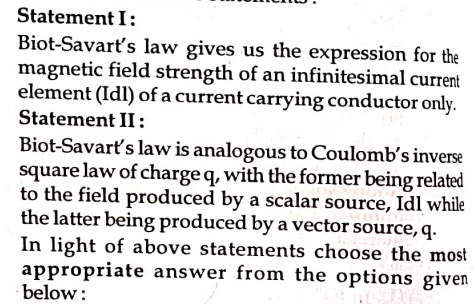Given below are two statements:

Both statement I and statement II are correct
Both Statement I and Statement II are incorrect
Statement I is correct and Statement II is incorrect
Statement I is incorrect and Statement II is correct
Step by step video & image solution for Given below are two statements: by Physics experts to help you in doubts & scoring excellent marks in Class 12 exams.
Topper's Solved these Questions
Similar Questions
Given below are two statement: p: 25 is a multiple of 5. q: 25 is a multiple of 8. Write the compound statement using connective "OR" and check its validity.
View SolutionGiven below are two statement : one is labelled as Assertion A and the other is labelled as Reason R:
Assertion A: Size of Np3+ ion is greater than Bk3+ ion.
Reason R: The above is a consequence of the lanthanoid contraction.
In the light of the above statements, choose the correct answer from the options given below :View Solution
Knowledge Check
- Question 1 - Select One
STATEMENT - 1 : When a rod lying freely is heated, no thermal stress is developed in it.
and
STATEMENT - 2 : On heating, the length of the rod increase.ABoth A and R are true but R is NOT the correct explanation of ABA is false but R is trueCA is true but Ris falseDBoth A and R are true and R is the correct explanation of A - Question 2 - Select One
Given below are two statement :
Statement-I: A speech signal of 2 kHz is used to modulate a carrier signal of 1 MHz. The band width requirement for the signal is 4 kHz.
Statement-II : The side band frequencies are 1002 kHz. and 998 kHz. In the light of the above statements, choose the correct answer from the options given below:AStatement I is true but Statement II is falseBStatement I is false but Statement II is trueCBoth Statement I and Statement II are trueDBoth Statement I and Statement II are false - Question 3 - Select One
Given below are two statement, one labelled as Assertion (A) and the other as Reason (R ).
Assertion (A) : Akbar, like Shershah,tried to regulated the currency of the state.
Reason (R ) : As in Shershah’s currency, the chief copper coin of Akbar’s time was the Dam
Select the correct answer from the codes given below:ABoth (A) and (R ) are true, and (R ) is the correct explanation of (A)BBoth (A) and (R ) are true, but (R ) is not the correct explanation of (A)C(A) is true, but (R ) is falseD(A) is false, but (R ) is ture
The question given below contain two statements giving certain data. You have to decide whether the data given in the statements are sufficient for answering the question ?
What is the age of Sonali ?
I. The ratio of the ages of Sonali and Meenu is 1:5.
II. After 7 years the ratio becomes 3: 8.View SolutionThe question given below contain two statements giving certain data. You have to decide whether the data given in the statements are sufficient for answering the question ?
Find the number of males and females in a party
I. The ratio of males and females is 3:2
II. The number of males is 50% more than the number of femalesView SolutionIn the question given below, are given two statements followed by a few conclusions. You have to take the two given statements to be true even if they seem to be at variance with commonly known facts. Read all the conclusions and then decide which of the given conclusions follow the two given statements disregarding commonly known facts.
Statements:
A. All spears are arrows
B. All arrows are bullets
Conclusions:
1. Some bullets are arrows
2. Some arrows are spears
3. Some bullets are spears
4. No bullet is an arrowView SolutionIn the question given below, are given two statements followed by a few conclusions as options. You have to take the two given statements to be true even if they seem to be at variance with connonly known facts. Read all the conclusions and then decide which of the given conclusions basically follows from the two given statements disregarding commonly known facts.
Statements:
1. All toys are books
2. All books are trains
Conclusions: ?
A. All traits are books
B. All books are toys
C. Some trains are toys
D. No train is a toyView SolutionIn the questions given below, there are two statements, Marked as Assertion (A) and Reason (R). Read the statements and choose the correct option.
Assertion (A): The chemical industry is fast growing and diversifying.
Reason (R): The chemical industry is its own largest consumer.View Solution
